With communities across the world calling for dramatic change in policing, agencies may wonder how to proceed. One necessary response is a true embrace of community policing, and agencies can benefit from the experiences of an agency who, in recent years, has been implementing the very reforms called for today: Baltimore, Maryland.
After the in-custody death of Freddie Gray in 2015 and the resulting community unrest, the Baltimore Police Department entered into a federal consent decree that mandated sweeping changes across the agency’s operations to remedy unconstitutional practices and build public trust. Now, the Baltimore Police Department has developed its first-ever Community Policing Plan, based on research and extensive community and officer input. This plan—and its rigorous development process—presents an example of how agencies can begin to meet the needs of the current moment by turning the community policing philosophy into agency-wide action to build trust and enhance problem-solving efforts to deliver better outcomes in partnership with the community.
Developing a Community Policing Plan
Creating a community policing plan is fundamental to implementing community policing effectively throughout an agency. Without a plan, an agency might not progress far beyond generic community engagement events and a vague understanding of the community policing mission. Effective plans must provide officers with clear roles and responsibilities and communicate how their daily actions contribute to the mission.
Agencies do not need to reinvent the wheel with their plans, but each agency needs to make the plan its own. Agencies need to create a thoughtful process for developing and implementing a community policing plan based on research and input from a wide variety of community and agency stakeholders Baltimore undertook a multistep process to create its first plan to improve services to the community.
Review of Community Policing Research
Community policing is frequently discussed amid conversations about reform, but does it work? According to a systematic review on the topic by researchers, there is “robust evidence that community policing increases satisfaction with police, elements of police legitimacy, and citizen perceptions of disorder.” On the other hand, the review did “not find an overall significant effect on crime.” That said, the authors also recognized “a number of challenges in assessing the effectiveness” of community policing overall, including different interpretations and applications of the concept and the lack of a standard community policing model or accepted structure.1
The authors then identify a natural next step: “Identifying the specific components that are implemented in collaboration with the community, such as problem-solving, may be key to refining [Community-Oriented Policing] as an intervention and assessing its effectiveness.” To this end, the authors add, “It is unlikely that the police simply engaging more with citizens is in itself sufficient to prevent crime; specific strategies like problem-oriented policing may mediate the relationship between community engagement and crime control.”2 Thus, community policing must be far more than positive engagement, but this type of trust building seems to harbor potential for enhanced problem-solving, which other research demonstrates has an impact on crime.3
With this in mind, the Baltimore Police Department set out to create a Community Policing Plan that responded to these research findings by
■ establishing a clear implementation model connecting planned activities with desired outcomes to not just build trust but also reduce crime and disorder in collaboration with the community; and
■ emphasizing problem-solving as a key element to achieving those outcomes, building on comprehensive initiatives to build relationships and trust.
Review of Community Policing Resources and Plans
Many organizations have put tremendous thought into effective community policing, and agencies should tap into this collective knowledge base to inform the development of their plans. Reviewing resources from IACP, the Office of Community Oriented Policing Services, and other leading institutions and agencies can provide a strong foundation for plan development in collaboration with the community.
Community Input on Performance and Priorities
Effective community policing plans must reflect the priorities and perspectives of the community. Creating the plan in collaboration with the community not only establishes the legitimacy and future potential of the plan, but it also presents an opportunity to productively engage with community members, kickstarting the increased collaboration to come.
As part of its reform process, Baltimore conducted multiple community surveys and focus groups to identify trends in community perceptions and priorities.4 The feedback clearly indicated a desire for improved relationships between the police and the community and provided wide-ranging community input on how to accomplish this.
Officer Input on the State of Community Policing—and the Path Forward
Agencies often state they embrace community policing, but what does that mean for officers throughout the agency? According to an officer focus groups conducted in Baltimore, “Officers from every rank struggled to explain the department’s approach to and expectations for engaging in community policing.”5 Agencies cannot expect officers to implement community policing unless leadership has presented a clear plan with actionable directives to carry out community policing as part of their regular duties. This became a core focus of the Baltimore plan: providing context, specificity, and clarity to enable all officers to become community policing officers. Officers voiced a variety of other essential concerns and recommendations for developing and successfully implementing the plan.
Public Comments on Draft Community Policing Plan
After drafting the plan through the above process and revising based on the input from subject matter experts overseeing the consent decree and the National Police Foundation, Baltimore posted the draft plan on its website for a public comment period. Based on this feedback, the agency added a specific set of community responsibilities to the plan and made responsive adjustments and then reposted the plan for a second public comment period to ensure the revised draft met the community’s expectations for reshaping policing in Baltimore moving forward.
Through this process, the Baltimore Police Department co-created its first-ever Community Policing Plan in partnership with the community, providing a framework for improved services.
The Baltimore Community Policing Plan: Framework and Key Elements for Success
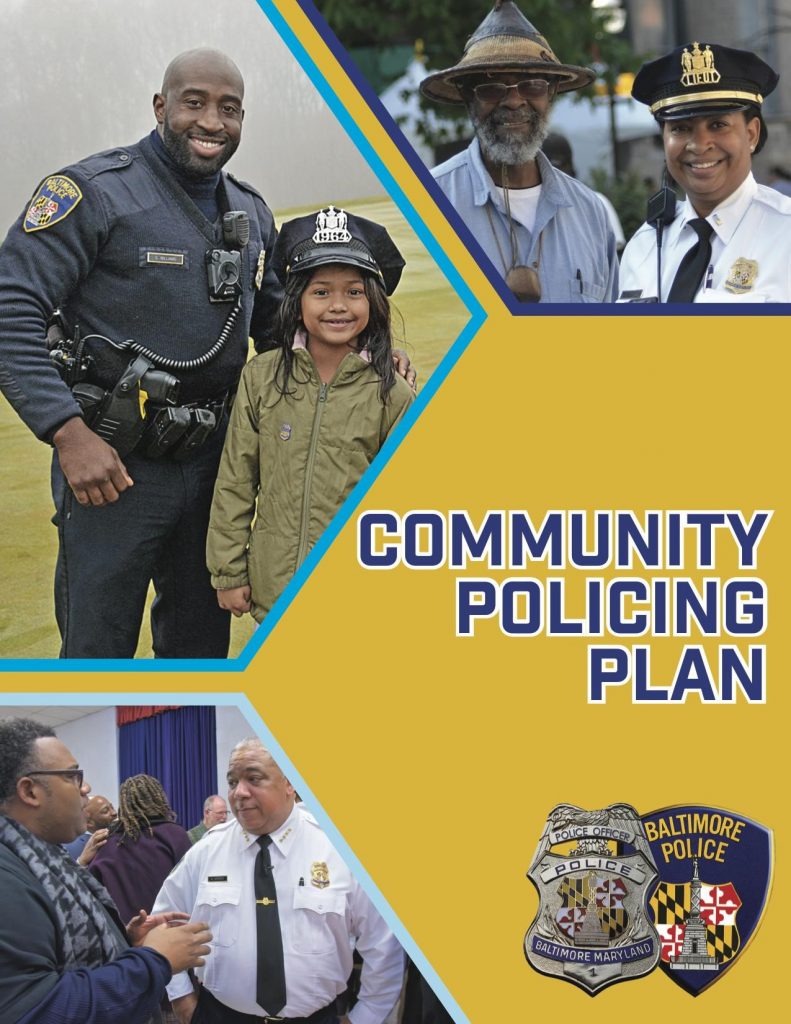 The Baltimore Police Department’s Community Policing Plan states its intent immediately:
The Baltimore Police Department’s Community Policing Plan states its intent immediately:
The mission of this Community Policing Plan is to institutionalize Community Policing principles throughout the Baltimore Police Department to:
1. Improve police-community relations, and
2. Reduce crime and disorder through collaborative problem-solving partnerships with the community.6
The Community Policing Plan does not operate in isolation toward these goals; it is core to a broader reform and transformation effort. Accordingly, the Community Policing Plan contextualizes its mission as operating in conjunction with the department’s overall improvement efforts detailed in its Crime Reduction & Departmental Transformation Plan.7 Community policing operating in tandem with reforms on use of force and enforcement tactics, for example, is necessary to building trust, collaborating with the community, and successfully implementing community policing.
With the Community Policing Plan’s mission and context established, it then proceeds to define key terms, present an overarching implementation model in detail, delineate roles and responsibilities, articulate methods for monitoring outputs and outcomes, and chart a timeline for implementation. Excerpts from these sections follow to summarize how the plan works and to provide a framework for implementing community policing throughout an agency.
Defining Key Terms for Shared Understanding
The Community Policing Plan defines key terms that are used throughout the plan to ensure members and the public have a shared understanding of the goals and activities of the plan, which is critical to implementing the plan in practice. Agency members frequently hear phrases like “community policing,” but do they have a consistent definition and understanding? In Baltimore, officers voiced a lack of clarity around what the department meant by community policing or how to implement it, so defining terms in the plan was necessary for generating consistent understanding and application. (See Figure 1 for an excerpt from the Baltimore plan.)
Figure 1. Baltimore Community Policing Plan: Key Terms (Excerpt)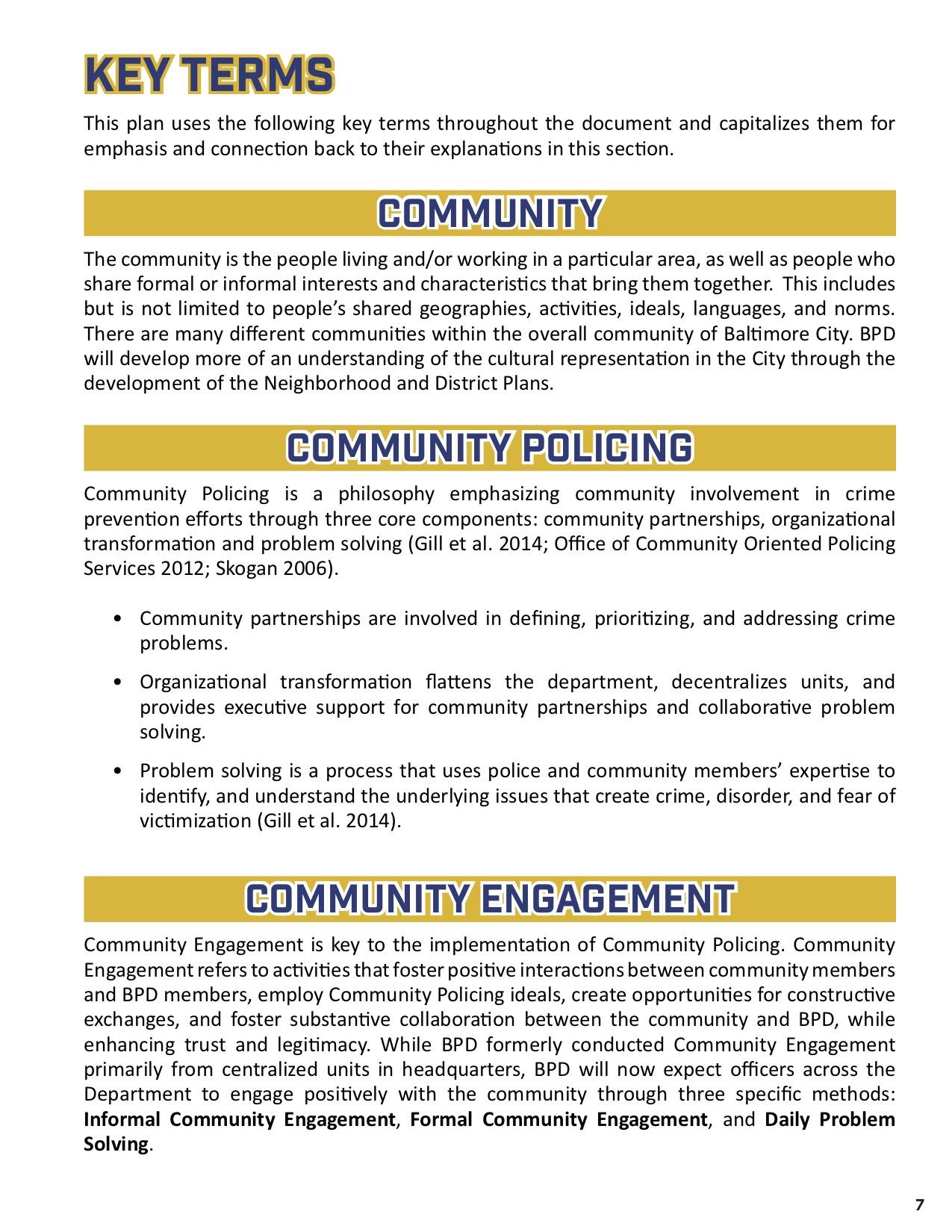
Implementation Model and Roles and Responsibilities
With key terms defined for common understanding, the plan then outlines the approach to implementing community policing. Baltimore structured its Community Policing Plan around a strategic implementation model connecting efforts toward the delivery of the desired outcomes, in response to the previously discussed research findings.
Figure 2: Baltimore Community Policing Plan Implementation Model
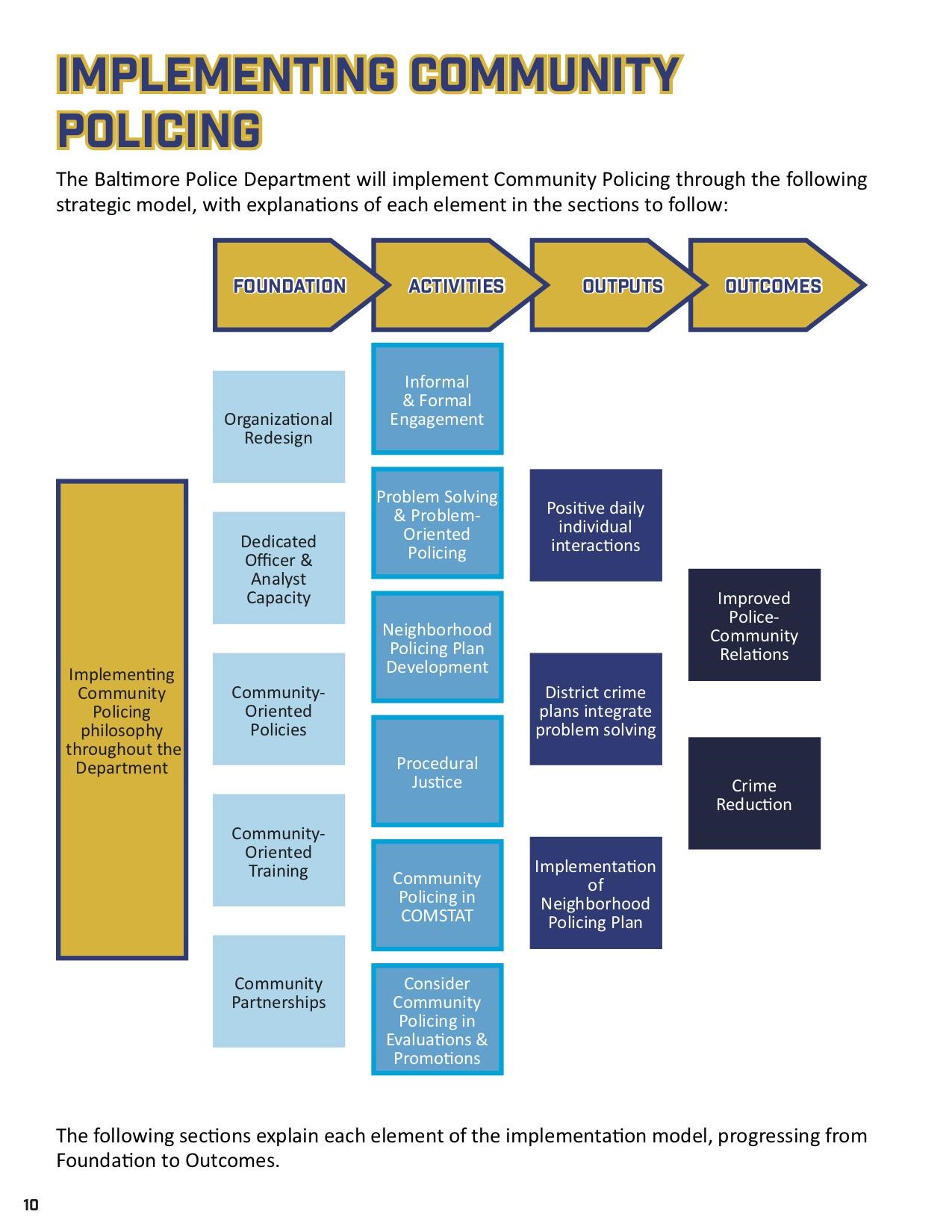 Figure 2 provides a visual overview of the implementation model as well as a framing structure for the Community Policing Plan. The implementation model will serve as a key orientation device in department-wide training on implementing community policing, showing how the pieces fit together and that everyone plays a role in improving outcomes.
Figure 2 provides a visual overview of the implementation model as well as a framing structure for the Community Policing Plan. The implementation model will serve as a key orientation device in department-wide training on implementing community policing, showing how the pieces fit together and that everyone plays a role in improving outcomes.
Following the introduction of the implementation model, the plan explains each element depicted on the implementation model, detailing the department-wide efforts on a variety of levels to implement community policing, from foundational efforts like orienting policy and training toward community priorities to ensuring the role of procedural justice and problem-solving as everyday activities.
Figure 3 presents an excerpt of the section that explains the activities the Baltimore Police Department expects to produce outputs that will lead to the desired outcomes of improved trust and reduced crime and disorder.
Figure 3. Baltimore Community Policing Plan: Implementation Model Explanation (Excerpt)
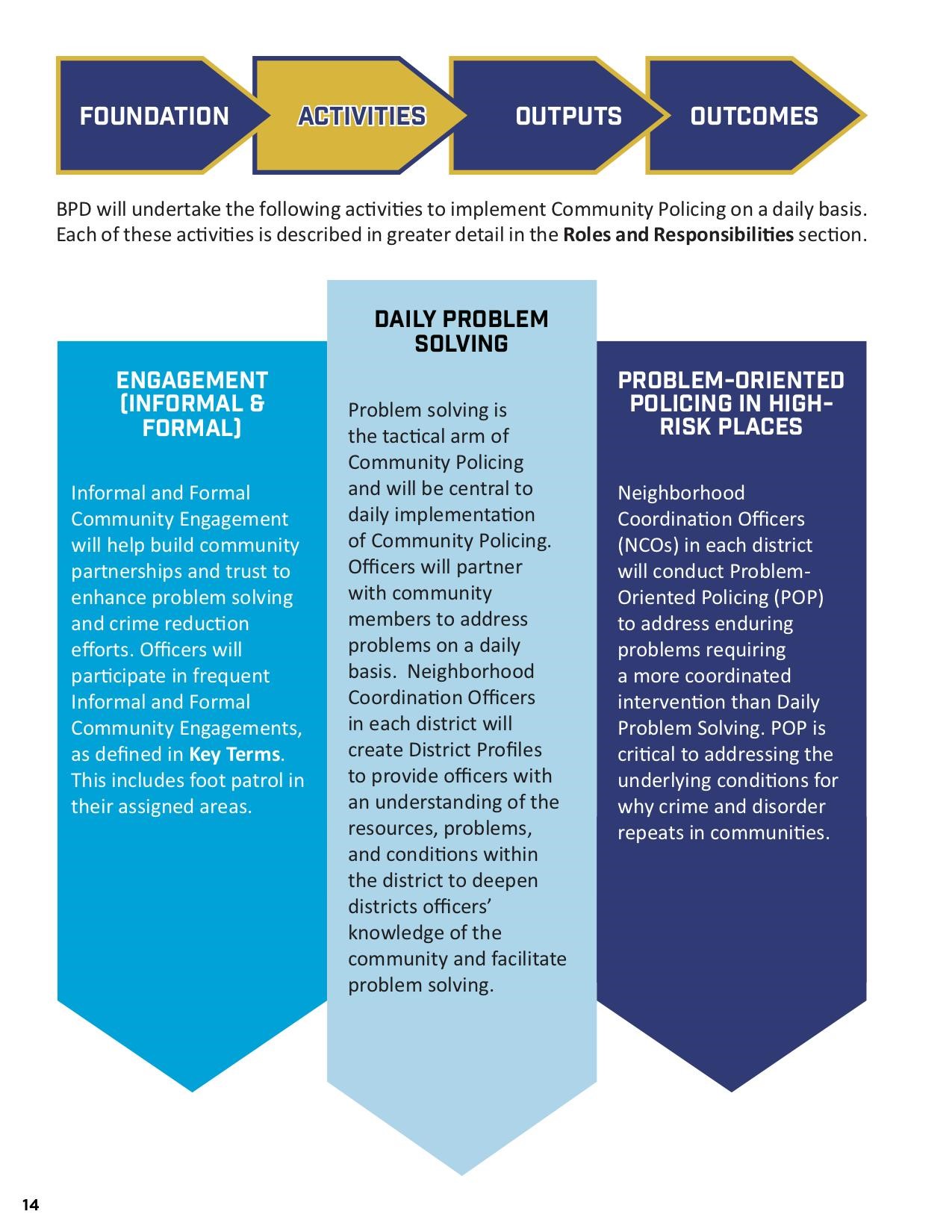
Important, the Community Policing Plan emphasizes not just positive community interactions but also collaborative, daily problem-solving, and higher-level problem-oriented policing (which might not directly involve community members) as core to effective policing and delivering the desired outcomes of the plan.
Defining Roles and Responsibilities of Officers and Community
After explaining the implementation model and how the pieces of the plan work together toward the desired outcomes at the departmental level, the plan delineates specific roles and responsibilities for all ranks and units to provide clear guidance on how to implement community policing in daily operations and deliver the key elements identified in the implementation model. (See Figure 4 for a partial snapshot of the roles and responsibilities for patrol officers.)
Figure 4. Baltimore Community Policing Plan: Roles and Responsibilities for Patrol Officers (Excerpt)
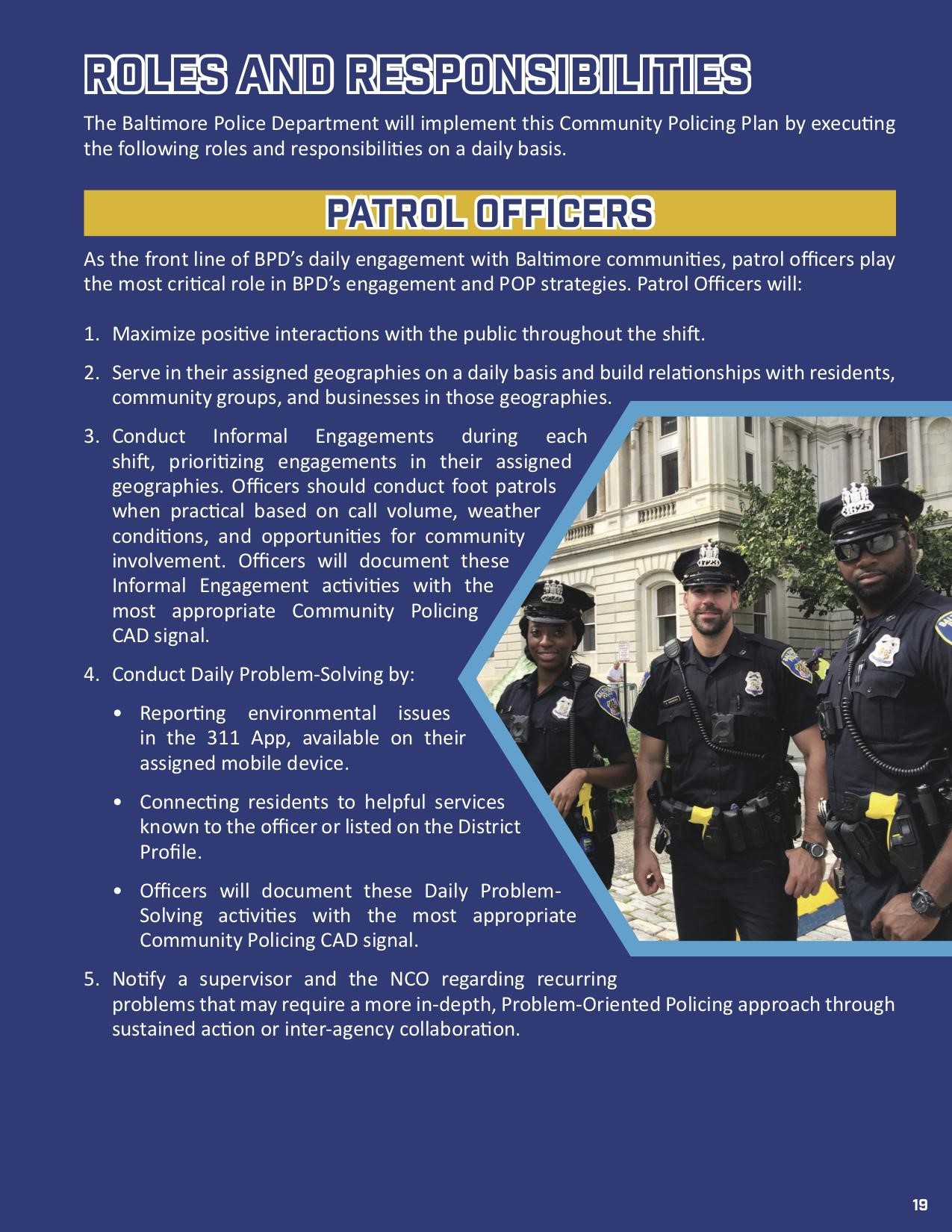
Providing this level of specificity on roles and responsibilities is essential to carrying out community policing with fidelity on a daily basis and delivering the desired outcomes of the plan. A key tenet in developing the Community Policing Plan was not to just say what community policing is but to specifically direct members on how to implement it in practice.
Likewise, with community policing requiring co-ownership of public safety by the police and community, the plan also includes specific opportunities for community members to participate in the implementation of community policing and the efforts to build a better Baltimore.
Figure 5. Baltimore Community Policing Plan: Roles and Responsibilities of Community Members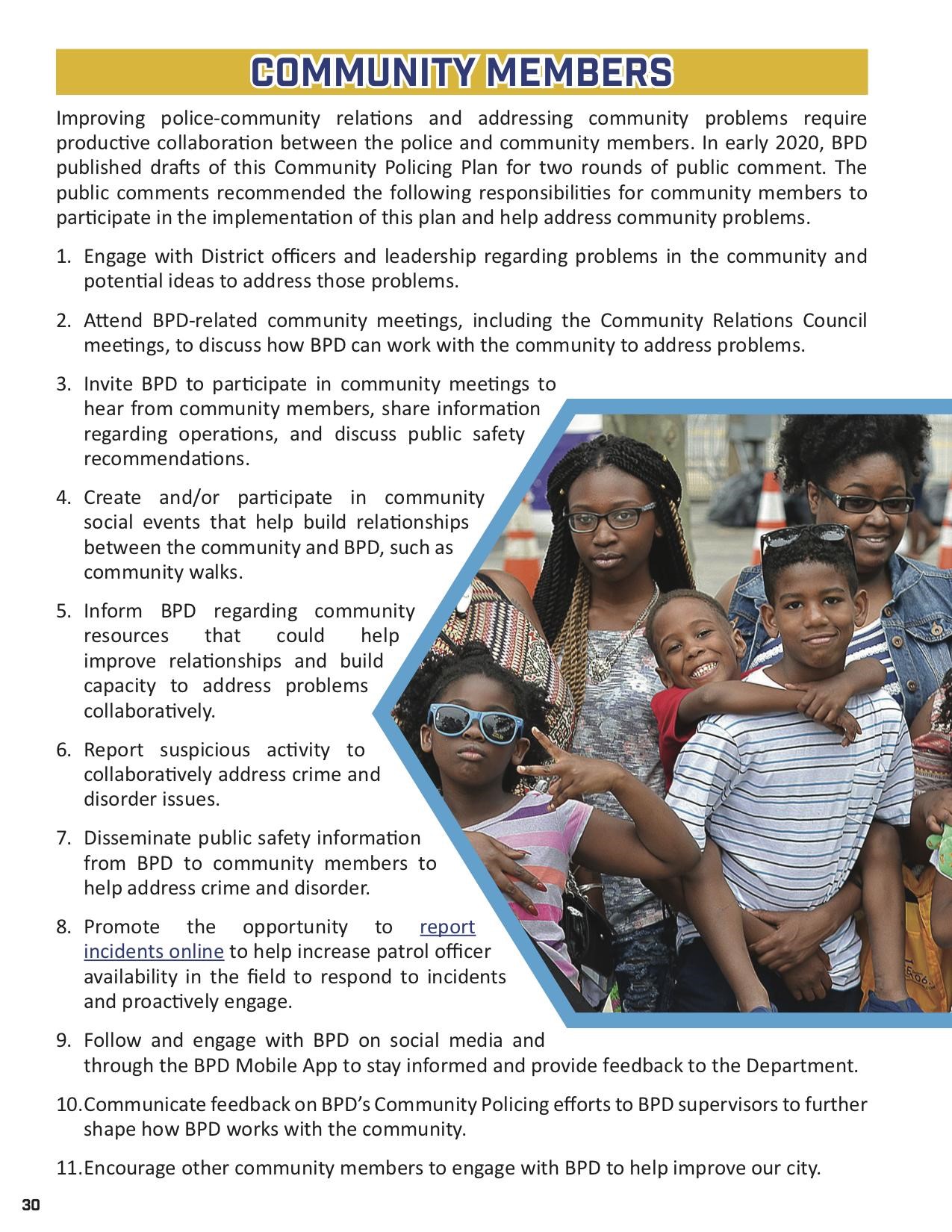
Key Themes: Every Officer Is a Community Policing Officer
For community policing to be an agency-wide philosophy, it cannot be the job of a dedicated unit—it has to be everyone’s responsibility. Baltimore’s strategy emphasizes decentralized responsibility for community policing with centralized coordination support at both the district and departmental levels. The Community Policing Plan requires all officers to serve as community policing officers with centralized support services to facilitate implementation. Neighborhood coordination officers (NCOs) in each district will facilitate community policing efforts with a particular focus on formal engagement and problem-oriented policing (POP) projects that might not always be possible in the regular scope of a patrol officer’s duties. Patrol officers can refer intensive problems to NCOs for a POP response. The Patrol Support Services Section acts as a department-level centralized hub for coordinating community policing efforts across districts and non-patrol units to maximize impact.
Key Themes: Procedural Justice to Increase Legitimacy and Collaboration
For community policing to work, the police must be perceived as legitimate and worthy of community collaboration. According to research, “citizens are more likely to cooperate with the police and obey the law when they view the police’s authority as legitimate.” Research finds that practicing procedural justice is “the most important pathway to police legitimacy”; thus, procedural justice principles are infused throughout the plan. Further, procedural justice not only can “enhance legitimacy” but also can “reduce reoffending, and promote citizen satisfaction, confidence, compliance and cooperation with the police.”8
Given the paramount importance of consistently demonstrating procedural justice, agencies need to turn the concept into actionable directives for officers to produce the associated positive outcomes. Baltimore has emphasized procedural justice throughout the Community Policing Plan, drafted a specific policy on procedural justice to equip officers with clear policy guidance, and infused procedural justice throughout reform training. BPD also included the following training aid in its “Officer Pocket Guide,” which provides useful reminders to officers on how to effectively carry out their duties on a daily basis (see excerpt in Figure 6).
Figure 6. BPD Officer Pocket Guide Excerpt: Procedural Justice in Stops, Searches, and Arrests
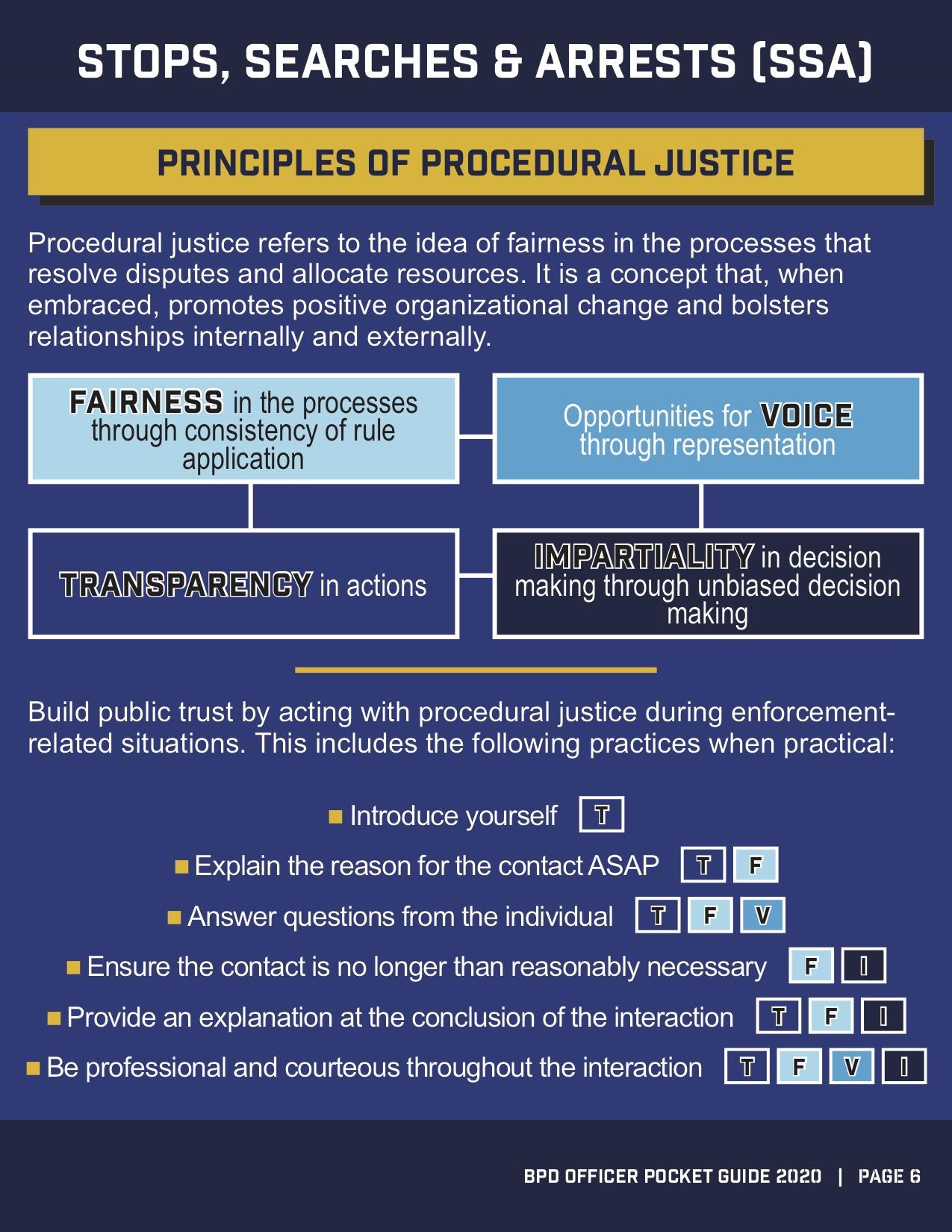
To ensure procedural justice is carried out in practice, Baltimore will conduct body-worn camera reviews to assess whether procedural justice is demonstrated in a wide variety of interactions, present the results broken out by district in a digestible scorecard format, and hold commands accountable during CompStat meetings. A similar approach in New Orleans, Louisiana, produced increases in procedural justice practices, coinciding with increases in public trust and improved quality of community-police interactions, according to surveys.
Key Themes: Problem-Solving to Address Community Concerns and Crime
As reiterated multiple times throughout this article, Baltimore’s Community Policing Plan emphasizes the role of daily problem-solving, as well as more intensive problem-oriented policing, to address community problems. The plan decentralizes the responsibility for daily problem-solving and identification of issues requiring POP, assigning it to all members, with NCOs in each district coordinating POP responses under the centralized guidance of the Patrol Support Services Section, which acts as centralized hub at the department level for community policing coordination. Baltimore is adding problem-solving initiatives as part of its weekly crime plans and will discuss these projects regularly in CompStat to monitor ongoing outputs and eventual outcomes.
Figure 7. Baltimore Community Policing Plan: Defining Problem-Oriented Policing
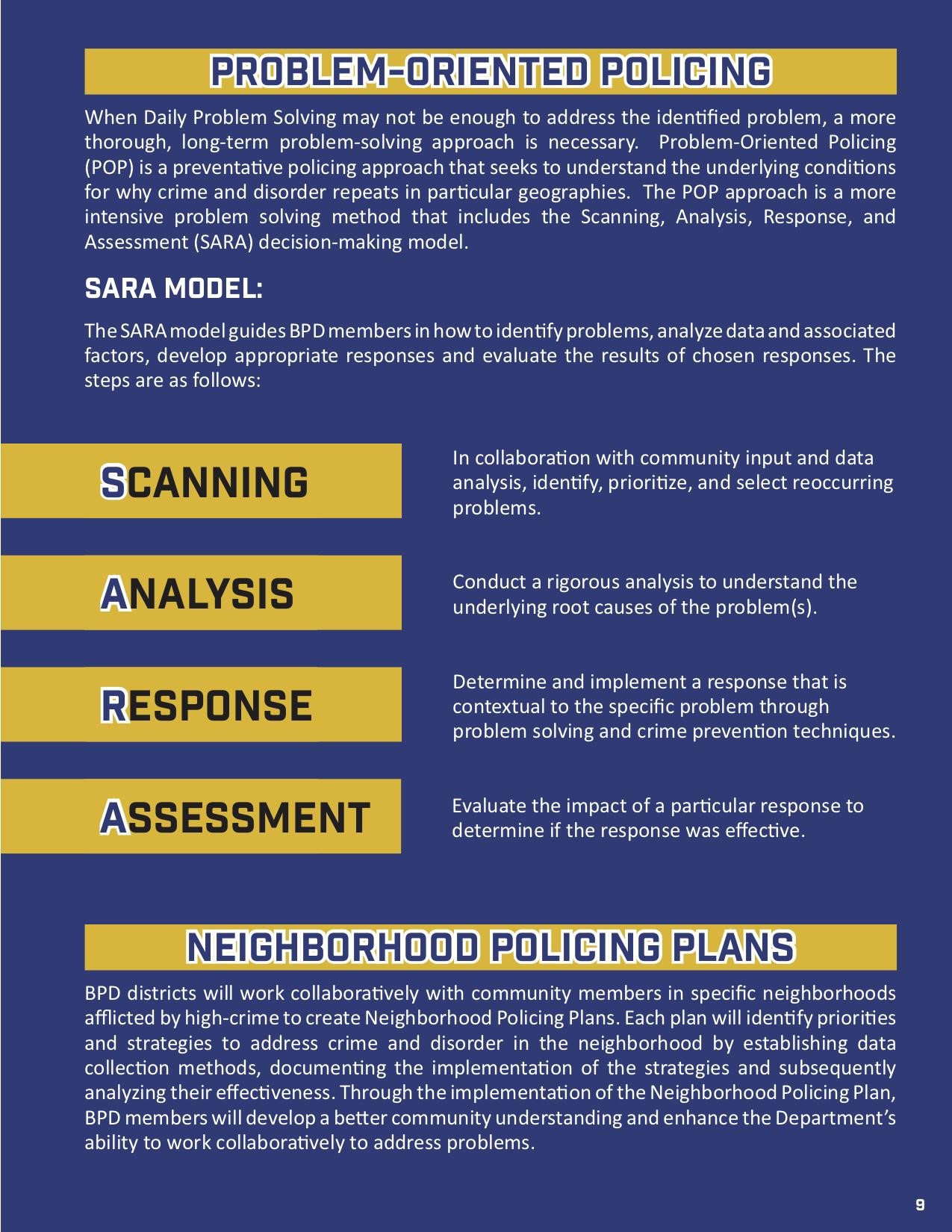
Implementation Timeline
A key to any successful plan is clearly stating who will do what when. Baltimore’s Community Policing Plan includes a detailed implementation timeline to provide a transparent roadmap for the implementation process and increase accountability for implementation. (See Figure 8.)
Figure 8. Baltimore Community Policing Plan: Implementation Timeline (Excerpt)
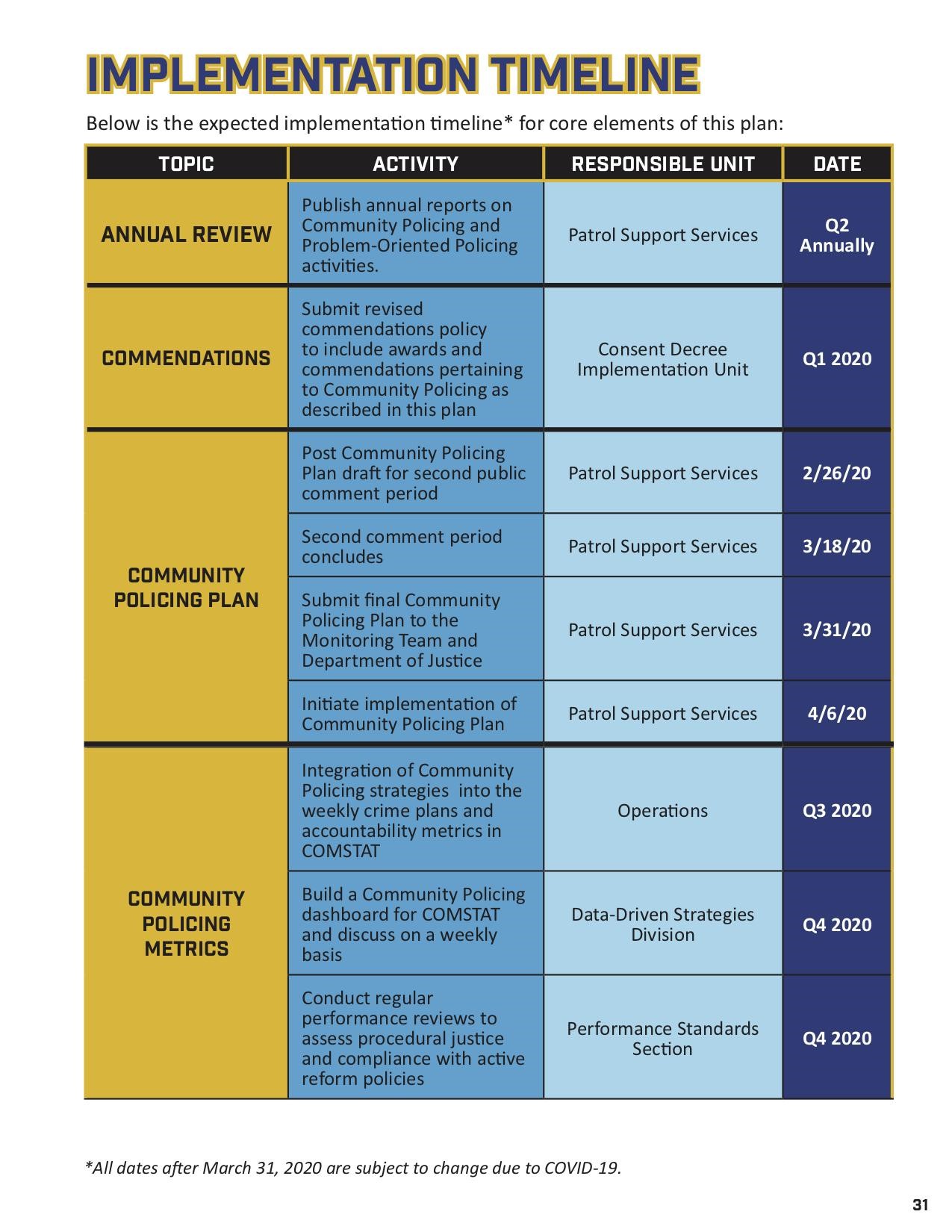
Developing Community Policing Training with the Community
With the inaugural Community Policing Plan finalized, the Baltimore Police Department is now developing comprehensive training to facilitate the successful implementation of the plan. Training development will largely mirror the development process for the plan, steeped in research, community partnerships, officer input, public comment opportunities, and training pilots in advance of department-wide delivery.
Baltimore will work with community groups to co-develop the training to ensure it is infused with community perspectives and priorities. Internal community policing subject matter experts and curriculum developers will work to ensure the training is relevant, actionable, and engaging and applies adult-learning approaches.
When the department concludes a first draft of the training curriculum, it will post the materials online for public comment from community members and officers alike. The police department will then revise the materials, as appropriate; repost the materials for a second round of public comment; and revise accordingly once more.
With the curriculum nearing finalization, Baltimore will present a condensed pilot of the training to its Community Training Review Committee, which is composed of community members across the city, for further community input on the curriculum in action and the effectiveness of its delivery. Baltimore will also pilot the training at least twice with groups of officers to gather feedback for refinement and improvement in advance of delivering the training to the whole department. The training must work for both the community and the police, so vetting the training with both groups in advance of delivery will help ensure it advances community policing implementation.
This, obviously, is a rigorous process for delivering a high-quality plan and training to serve as the foundation for transforming the Baltimore Police Department into a true community policing department. Given the intensive nature of the development process, Baltimore plans to deliver interim e-learning modules on the Community Policing Plan to accelerate its effective implementation in the near future, with comprehensive, department-wide training on the horizon.
Monitoring Implementation and Impact
At the end of the day, implementing a Community Policing Plan is about delivering better services to the community, so measuring the outputs and outcomes of the plan is essential to monitoring effectiveness and adjusting strategies as necessary. Baltimore’s Community Policing Plan presents a variety of mechanisms for measuring the outputs and outcomes of the plan to assess effectiveness. These mechanisms include community policing CAD signals to track activities and impacts, 311 reports, formal engagement tracking, problem-oriented policing documentation and assessment, procedural justice and other reforms, body-worn camera audits, and community feedback channels and surveys. BPD will create a community policing dashboard as part of CompStat for ongoing monitoring and produce annual public reports to communicate the activities, successes, and opportunities for improvement in its community policing implementation moving forward.
Meeting This Moment with Community Policing
As Baltimore Police Commissioner Michael Harrison says, “The community will see us differently when they see us act differently.” Working with the community to co-create a community policing plan presents positive opportunities for sustained engagement and a framework for delivering policing services that is in line with community expectations and priorities. In the end, community policing is about working with the community to continually reimagine what policing should be in that community. This is essential both in this moment and moving forward.
Notes:
1 Charlotte Gill et al., “Community-Oriented Policing to Reduce Crime, Disorder and Fear and Increase Satisfaction and Legitimacy among Citizens: A Systematic Review,” Journal of Experimental Criminology 10 (August 2014): 399–428.
2 Gill et al. “Community-Oriented Policing to Reduce Crime, Disorder and Fear and Increase Satisfaction and Legitimacy among Citizens.”
3 Gill et al. “Community-Oriented Policing to Reduce Crime, Disorder and Fear and Increase Satisfaction and Legitimacy among Citizens”; David Weisburd et al., Effects of Problem-Oriented Policing on Crime and Disorder (November 2008).
4 See, National Police Foundation, Baltimore Community Input to the Baltimore Police Department Community Policing Plan (Arlington, VA: National Police Foundation, 2020). See also, Institute for Urban Research at Morgan State University, The Community’s Experiences and Perceptions of the Baltimore City Police Department Survey Report (Baltimore, MD: Morgan State University, 2020).
5 See Crime and Justice Institute, Feedback from the Field: A Summary of Focus Groups with Baltimore Police Officers (Boston, MA: Crime and Justice Institute, 2019). See also, National Police Foundation, Community Policing in Baltimore: Perspectives from Baltimore Police Department Personnel (Arlington, VA: National Police Foundation, 2019).
6 Baltimore Police Department, Community Policing Plan (2020).
7 Baltimore Police Department, Crime Reduction & Departmental Transformation Plan (2019).
8 Lorraine Mazerolle et al., “Legitimacy in Policing: A Systematic Review,” Campbell Systematic Reviews, 9, no. 1 (January 2013).
Please cite as
Danny Murphy, “From Crisis to Community Policing: How Baltimore Is Moving Forward,” Police Chief Online, July 22, 2020.



